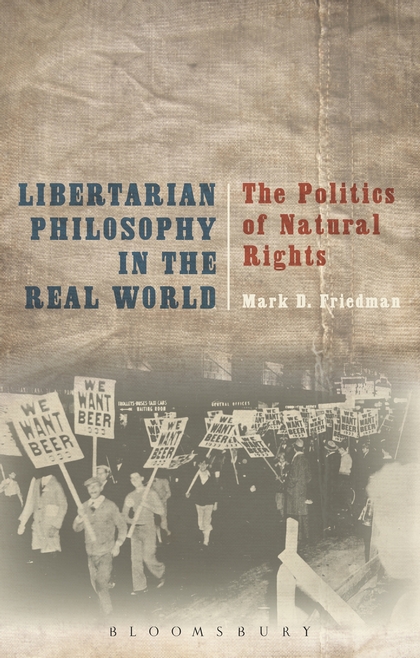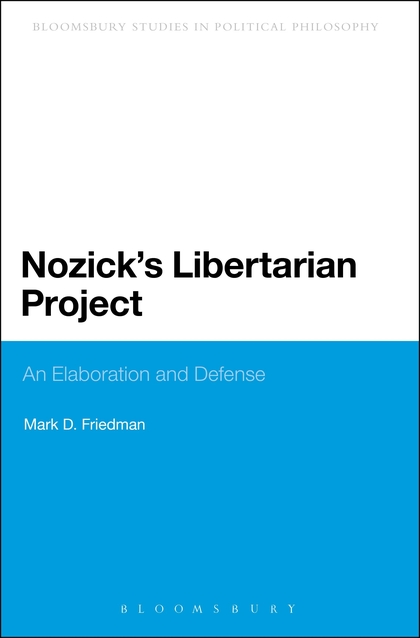Brink Lindsey, a well-known libertarian-minded journalist and VP at the Cato Institute, has recently published an online essay titled “The Poverty of Natural Rights Libertarianism.” His broadside is directed against the “radical” strand of rights-based libertarianism, that he characterizes as holding “only a minimal ‘night-watchman state’ or full-on anarcho-capitalism can satisfy the requirements of justice.” (for ease of reference, I will hereafter refer to this doctrine as “NRL”). His central claim is that NRL “is simply too open-ended, too indeterminate, to bear the burden that radical libertarians expect it to carry. In other words, it is impossible to derive a full-blown, operational legal order from these first principles.” (see his introduction; the essay is not paginated[i]). As I will show below, he makes a number of quite rudimentary errors, thus rendering his critique hopelessly feeble and ineffectual.
He identifies five “big questions of fundamental importance” that radical libertarians are supposedly unable to answer in a principled, definite way:
How should we balance freedom of action and security of rights? How should we balance the risks of unfreedom from above and those of unfreedom from below? How should we deal with past injustices? To what extent is the most complete possible protection of rights shaped by necessity – in particular, the demands of the poor and disaffected who have no stake in the system? And how should we deal with the outside world? (see “Conclusion”)
He asserts that because the doctrine of natural rights is “porous with ambiguity,” libertarians should “abandon radical libertarianism’s intellectual muddle altogether,” and undertake the “more constructive task of making the world we actually inhabit a better place.” Instead, I must presume, of our conscious efforts to make it worse.
Before going further, I must pause for an important observation. Lindsey’s piece purports to be a rigorous, intellectually serious critique of NRL. He notes correctly that it has been strongly influenced by Ayn Rand, Murray Rothbard, and Robert Nozick.[ii]
However, in this long (approximately 20-page) essay there is quite remarkably not a single quotation from any of these figures, nor from any other exemplar of this “bankrupt” movement. It is always “they imagine,” “according to radical libertarian theory,” “radical libertarians today generally hold,” and so on. This method either exemplifies willful intellectual dishonesty or is produced by extreme sloth, and in either case precludes any productive engagement with the ideas Lindsey purports to challenge.
I will respond to each of these claims in turn, but in light of the preceding paragraph, it should come as no surprise that all suffer from one or more of the following critical defects: a failure to take on the most plausible versions of natural rights theory; a misunderstanding of the ethical foundations of natural rights; an apparent ignorance of the crucial distinction between the nature and purpose of philosophical theories of justice versus political programs; and an ironclad refusal to undertake comparative analysis with rival theories of justice. In order to keep this post to a manageable length, I address the Lindsey’s first two charges here, and the final three in a later post.
Security of Rights versus Freedom of Action. According to Lindsey, NRL’s first failing is its inability to decide in any principled way “how secure should personal and property rights be?” He is referring here to the conflicts that arise between the right of persons to the quiet enjoyment of their possessions and the right of others “to make active and productive use of [their] property” (think pollution and the nonconsensual imposition of risks). Lindsey accurately observes that there are a wide variety of possible resolutions of such conflicts, using injunctive or monetary relief. Clearly, some of them would favor producers and those imposing risks, while others would offer greater protections to those unwillingly subjected to these negative externalities.
Sadly, he says, (unidentified) “modern-day radical libertarians…imagine only a narrow slice of the available options. Specifically, they imagine an order in which some people, notably entrepreneurs, are granted wide freedom of action to the detriment of other people’s security of rights.” While, Lindsey says, this outcome is a plausible interpretation of NRL, from the NRL perspective it is equally reasonable to privilege “security of rights,” in which case the result “can be a highly restrictive regulatory state.”
Drawing the right boundary here is certainly tricky, so the first question one would wish to ask Lindsey is: “what brilliant solutions to this puzzle have been advanced by competing conceptions of justice?” Strangely enough, he does not describe any favored solution that is foreclosed by NRL. Thus, it would appear that the problem here is not NRL’s alleged indeterminacy, but the inherent difficulty of balancing rights in this context.
Of course, one obvious and familiar way to manage widespread negative externalities is to employ cost-benefit analysis (“CBA”), implemented either through administrative regulations or as a legal standard applied in the tort system. Due to, among other things, the difficulty of measuring these inputs in any rigorous way, CBA is in practice a highly imperfect solution to this problem. Nevertheless, at least conceptually it is a fair and non-arbitrary way of determining which activities should be permitted and, critically, I have yet to hear a better method from Lindsey or anyone else.[iii]
The immediate point here, though, is that he gives no hint of awareness that this approach was endorsed by Nozick, one of his “bad boys”:
Since it would exclude too much to forbid all polluting activities, how might a society (socialist or capitalist) decide which polluting activities to forbid and which to permit? Presumably, it should permit those polluting activities whose benefits are greater than their costs. (ASU, 79)
Nozick then goes on to suggest that in cases where “individual polluters have widespread and individually miniscule effects,” class action lawsuits could be employed (ASU, 80).[iv]
A similar method is available to libertarians with respect to the imposition of non-consensual risk, e.g. the construction of a manufacturing facility for high explosives in a residential neighborhood. Here, instead of quantifying the costs and benefits of a project in purely economic terms, we could evaluate whether the benefits it would produce come at too high a price as measured by the trade-offs individuals typically make regarding the risks of death and injury (see ASU, 76-7). For example, one such data point is the amount that people are willing to spend for optional safety equipment in their automobiles.[v] If the risk created by a project does not expose people to a greater level than is generally accepted, it would be permitted.
Lindsey is either unaware of Nozick’s acceptance of CBA for certain purposes, or simply assumes that a “radical” champion of natural rights could not find room in his thinking for this strand of utilitarianism. The former supposition would bespeak a woeful ignorance, while the latter approach would represent grossly negligent scholarship. Had Lindsey chosen to engage with Nozick’s ideas he would have found (as argued here) that his embrace of CBA is consistent with Nozick’s general commitment to the stringency of libertarian rights, because it is limited to “common activities with widespread effects that can only be resolved by state, regional or federal policy.” It need not apply to “micro” cases, where Joe dumps garbage on Sam’s yard.
As I say in the above-referenced link, the administrative or judicial enforcement of air pollution standards based on CBA does not constitute impermissible coercion, because:
all members of the applicable jurisdiction experience the benefits and burdens of the policy. Accordingly…there is no obvious reason why being subjected to them violates Kantian “respect for persons.” The “victims” are only being asked to abide by the same rules that all members of the community must live with; rules that are designed to reflect, by means of CBA, the trade-offs that members of the affected community actually make in their day-to-day decisions.
It cannot be over-emphasized that this regulatory strategy is only acceptable to libertarians in dealing with widespread negative externalities, and is consistent with the stringency of property rights in all other cases. The great disvalue we attach to coercion rules out the “highly restrictive regulatory state” that Lindsey alludes to. Accordingly, he has plainly failed to show that pollution and nonconsensual risk present some unique or special problem for “radical” libertarians.
Rationalism versus Pluralism. Next, Lindsey (channeling Jacob Levy) argues that defenders of NRL are unable to agree on any set of institutional arrangements that will best protect liberty from the various threats it faces, both from “above” (the federal government) and “below” (private aggression). In other words, while a strong central authority (favored by “rationalists”) may protect citizens against oppression by private parties, it may itself turn against political dissidents and disfavored minorities. On the other hand, a weak central government (favored by “pluralists”), will allow civil society to flourish, but may permit illiberal groups to oppress their members.
Libertarian disarray on this question, says Lindsey, is demonstrated by the fundamental split between minimal state libertarians and the anarcho-capitalists on the justice of any state, however limited its powers may be. He concludes that this disagreement “makes clear that the best institutional structure cannot be deduced from reason alone.”
Moreover, he asserts that libertarians have no definite answer to the problem of isolated adults being abused and children brainwashed in illiberal communities, including “traditionalist religious groups and newfangled cults.” Too much outside interference may spark “an anti-libertarian backlash,” while too little may permit illiberal communities to eventually overwhelm any libertarian polity. In short, “Natural rights cannot deliver us to solid ground, because solid ground does not exist.”
This argument is confused on so many levels, that it almost induces intellectual paralysis. Perhaps the first thing to say here is that it would astonish me to discover that there is a prominent libertarian thinker who believes that Libertopia’s laws and institutions may be “deduced from reason alone,” and of course no such text is cited. In fact, all plausible theories of justice are at least implicitly grounded in certain empirical assumptions.
For example, socialists assume (falsely I believe) that the state’s ownership of the means of production will not produce severe shortages of basic goods, thereby inflicting misery on the very group of people its proponents say they wish to benefit. Similarly, libertarians suppose that unfettered free markets will not result in an exploitative society in which those with lesser natural endowments or bad luck are reduced to living as the slaves of the more fortunate. Lindsey gives us no reason to think that defenders of NRL would cling to their principles if their assumptions were proven to be fundamentally unsound.[vi]
Second, Lindsey’s analysis fails to recognize the profound and irreconcilable difference between philosophical theories of justice and the application of such theories to formulate social policy.[vii] Roughly speaking, this corresponds to the difference between what political philosophers call “ideal” and “non-ideal” theory.[viii]
By way of analogy, ideal theory is like a compass that informs you whether you are headed in the right direction; in this context, “justice.” Non-ideal theory is like the GPS system in your car that guides you to your destination in the shortest time, given prevailing traffic conditions, accidents, road closures, and so on. Not only are such systems fallible, but there may be unfortunate circumstances where it is simply impossible to reach your destination in time. Similarly, a political philosophy is not falsified by the circumstance that its recommendations are precluded for the foreseeable future by practical considerations.
Applying this distinction to the problem identified by Levy and cited by Lindsey, we should note that each of the three so-called radical libertarian philosophers mentioned above all abhor the coercion of peaceful persons. Their theories of justice all imply that competent adults have the right to live in illiberal communities if they choose.[ix] This robust right of free association would enable a virtually limitless variety of distinct communities to form, each based on a unique set of social/political norms.
Moreover, Nozick describes the “legal order” (demanded by Lindsey) that would instantiate this “framework for utopias.” That is, a minimal state that exists simply to ensure that one community does not aggress against others, while also protecting individuals’ right of exit. See ASU, Part III (“Utopia”). Again, Lindsey shows no awareness of this proposal.
The split between the minarchists and anarcho-capitalists trumpeted by Lindsey does not constitute any sort of philosophical embarrassment, but is a purely practical disagreement over what arrangement will best protect liberty in the highly imperfect and unjust world we now inhabit, populated by often aggressive nation-states and violent domestic criminals. Because the state is intrinsically coercive, all libertarians would like to abolish it. Minimal state libertarians simply believe that, given existing threats to liberty, a reasonably just state is currently the lesser evil.
In any event, Lindsey is on a fool’s errand. If he sincerely believes that theories of justice are best judged on how readily their basic tenets may be converted into a “full-blown, operational legal order,” then he should opt for communism. Its program is blissfully simple: the state should outlaw all private property, and distribute to each “according to their need.” Voila, the “operational legal order” was a great success, even though the patient died.
Thankfully, however, philosophers don’t use such a simple-minded criterion in evaluating theories of justice. They tend to prefer something like Rawls’s method of “reflective equilibrium,” whereby we (roughly) “examine our moral judgments about a particular issue by looking for their coherence with our beliefs about similar cases and our beliefs about a broader range of moral and factual issues.” To make an appropriate judgment of “radical libertarianism” on this basis, Lindsey would need to think like a philosopher; something he is either disinclined to do or incapable of.
With respect to the problem that may be presented by children raised in isolated communities, Nozick expressly recognizes this as a challenge to his “framework for utopia.” He notes that, “In some way it must be ensured that they are informed of the range of alternatives in the world” (ASU, 330), but forthrightly admits that this is one of many details he is leaving unresolved. However, it is facile to criticize libertarian theorists for not having a pat answer to this problem unless Lindsey can cite a better solution available from those espousing competing theories of justice, and he offers none. I’ll even add fuel to Lindsey’s fire, and admit that libertarian theory won’t solve male pattern baldness anytime soon either.
In short, the various threats to liberty described by Levy and cited by Lindsey are second order problems. A theory of (political) justice must first delineate the rights and responsibilities that members of a community have vis-a-vis each other, and what role coercive government should play in vindicating the former and enforcing the latter. Only then do we turn to the “operational legal order” required to implement this ideal.
Given the complexity of human psychology, our lack of experience with even a minimal state, and the inevitable problems of ensuring compliance, there will certainly be obstacles to be overcome in implementing the libertarian ideal. However, objecting to NRL because it cannot solve every social problem or specify in advance the precise set of rules to be enforced is like rejecting quantum mechanics because it does not prescribe exactly how to fix that mysterious glitch in your car’s electrical system.
Finally, Lindsey gives us no reason to conclude that the obstacles facing libertarians in this regard would be worse than those confronting other “liberal” theories of justice, such as Rawlsian egalitarianism, rule consequentialism, luck egalitarianism, and so on. Even if they are more daunting, why would any sane person prefer a decidedly inferior theory of justice that is “plug and play” over a morally superior rival that will require some trial and error?
_______________
[i] Unless otherwise indicated, all further quotations from Lindsey’s article are found within the parts of his essay indicated in the corresponding section headings of this post.
[ii] Because I regard Nozick’s version of natural rights libertarianism as by far the most rigorous and philosophically sophisticated version of this philosophy, my reply to Lindsey makes liberal use of Nozick’s arguments from his classic Anarchy, State, and Utopia (New York: Basic Books, 1974).
[iii] For a much fuller discussion of this proposal, see my Nozick’s Libertarian Project, 150-9.
[iv] He also references the possible use of a “cap and trade” system of pollution control. See ASU, 81n. Rothbard also proposes the use of the tort system to manage pollution, although in a way more favorable to those generating externalities.
[v] See NLP, 153-4.
[vi] Nozick, at least, would not have to, as his “Lockean proviso” would quite clearly require the redistribution of holdings in the event of such a nightmare scenario. See ASU, 175-80. Again, Lindsey shows no evidence of any awareness of this aspect of Nozick’s thinking.
[vii] See SEP entry, John Rawls, sec. 2.3.
[viii] See Laura Vakentini (2012) “Ideal vs. non-ideal theory: a conceptual map.” Philosophy Compass, 7 (9). pp. 654-664.
[ix] Thus, the fundamental libertarian commitment to respect the autonomy of competent adults makes the “Union of Liberty” model proposed by Chandran Kukathas, and described by Lindsey, a non-starter.






